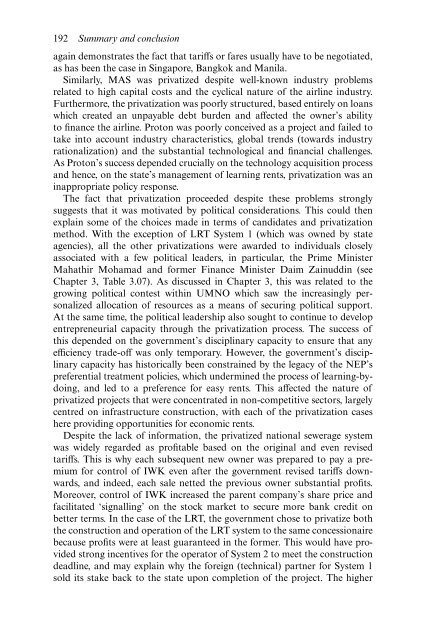PRIVATIZATION Privatization in Malaysia, Regulation, rent-seeking and policy failure
PRIVATIZATION Privatization in Malaysia, Regulation, rent-seeking and policy failure
PRIVATIZATION Privatization in Malaysia, Regulation, rent-seeking and policy failure
You also want an ePaper? Increase the reach of your titles
YUMPU automatically turns print PDFs into web optimized ePapers that Google loves.
192 Summary <strong>and</strong> conclusionaga<strong>in</strong> demonstrates the fact that tariffs or fares usually have to be negotiated,as has been the case <strong>in</strong> S<strong>in</strong>gapore, Bangkok <strong>and</strong> Manila.Similarly, MAS was privatized despite well-known <strong>in</strong>dustry problemsrelated to high capital costs <strong>and</strong> the cyclical nature of the airl<strong>in</strong>e <strong>in</strong>dustry.Furthermore, the privatization was poorly structured, based entirely on loanswhich created an unpayable debt burden <strong>and</strong> affected the owner’s abilityto f<strong>in</strong>ance the airl<strong>in</strong>e. Proton was poorly conceived as a project <strong>and</strong> failed totake <strong>in</strong>to account <strong>in</strong>dustry characteristics, global trends (towards <strong>in</strong>dustryrationalization) <strong>and</strong> the substantial technological <strong>and</strong> f<strong>in</strong>ancial challenges.As Proton’s success depended crucially on the technology acquisition process<strong>and</strong> hence, on the state’s management of learn<strong>in</strong>g <strong>rent</strong>s, privatization was an<strong>in</strong>appropriate <strong>policy</strong> response.The fact that privatization proceeded despite these problems stronglysuggests that it was motivated by political considerations. This could thenexpla<strong>in</strong> some of the choices made <strong>in</strong> terms of c<strong>and</strong>idates <strong>and</strong> privatizationmethod. With the exception of LRT System 1 (which was owned by stateagencies), all the other privatizations were awarded to <strong>in</strong>dividuals closelyassociated with a few political leaders, <strong>in</strong> particular, the Prime M<strong>in</strong>isterMahathir Mohamad <strong>and</strong> former F<strong>in</strong>ance M<strong>in</strong>ister Daim Za<strong>in</strong>udd<strong>in</strong> (seeChapter 3, Table 3.07). As discussed <strong>in</strong> Chapter 3, this was related to thegrow<strong>in</strong>g political contest with<strong>in</strong> UMNO which saw the <strong>in</strong>creas<strong>in</strong>gly personalizedallocation of resources as a means of secur<strong>in</strong>g political support.At the same time, the political leadership also sought to cont<strong>in</strong>ue to developentrepreneurial capacity through the privatization process. The success ofthis depended on the government’s discipl<strong>in</strong>ary capacity to ensure that anyefficiency trade-off was only temporary. However, the government’s discipl<strong>in</strong>arycapacity has historically been constra<strong>in</strong>ed by the legacy of the NEP’sprefe<strong>rent</strong>ial treatment policies, which underm<strong>in</strong>ed the process of learn<strong>in</strong>g-bydo<strong>in</strong>g,<strong>and</strong> led to a preference for easy <strong>rent</strong>s. This affected the nature ofprivatized projects that were concentrated <strong>in</strong> non-competitive sectors, largelycentred on <strong>in</strong>frastructure construction, with each of the privatization caseshere provid<strong>in</strong>g opportunities for economic <strong>rent</strong>s.Despite the lack of <strong>in</strong>formation, the privatized national sewerage systemwas widely regarded as profitable based on the orig<strong>in</strong>al <strong>and</strong> even revisedtariffs. This is why each subsequent new owner was prepared to pay a premiumfor control of IWK even after the government revised tariffs downwards,<strong>and</strong> <strong>in</strong>deed, each sale netted the previous owner substantial profits.Moreover, control of IWK <strong>in</strong>creased the pa<strong>rent</strong> company’s share price <strong>and</strong>facilitated ‘signall<strong>in</strong>g’ on the stock market to secure more bank credit onbetter terms. In the case of the LRT, the government chose to privatize boththe construction <strong>and</strong> operation of the LRT system to the same concessionairebecause profits were at least guaranteed <strong>in</strong> the former. This would have providedstrong <strong>in</strong>centives for the operator of System 2 to meet the constructiondeadl<strong>in</strong>e, <strong>and</strong> may expla<strong>in</strong> why the foreign (technical) partner for System 1sold its stake back to the state upon completion of the project. The higher


